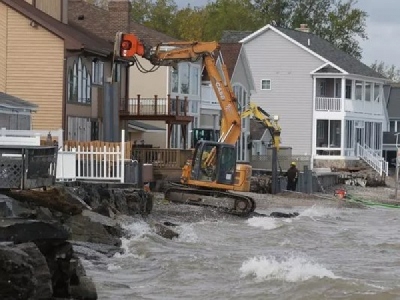
Posted on February 8, 2018
By Steve Orr, Democrat & Chronicle
Gov. Andrew Cuomo, fearful of more flooding on the Lake Ontario shoreline, has asked federal officials to build more protective bulwarks.
Officials at the Army Corps of Engineers are considering the request, a spokesman said Monday.
Cuomo sent a letter to the Corps of Engineers Saturday asking the agency to install extra protection along as many as 90 stretches of the Lake Ontario and Lake Erie shorelines, including 13 locations in Monroe County.
The protection, meant to be relatively temporary, might involve placement of rocks, boulders, earth or other structures to break up or hold back waves.
The governor invoked a particular Corps program that is meant to help with demonstrable risks posed by natural disasters that are foreseen in advance.
Cuomo’s letter referenced the months-long flooding of the Lake Ontario shoreline last spring and summer, and asserted “there is a serious threat for renewed coastal flooding in 2018.”
What wasn’t clear Monday was if the Corps would agree that shoreline flooding is both foreseeable and imminent. If they do not agree, they could reject the request.
The lake level has been roughly a foot above the long-term average since late last fall. Partly that is by design; the new lake-level regulatory plan calls for higher water in early winter than had been the case before.
Releases from the lake have been stepped up to record levels for this time of year, though the lake level likely will remain above the long-term average for some time.
Many shoreline residents see the elevated level as evidence that history will repeat itself this spring, but flooding is by no means certain despite the current level.
Since lake-level regulation began in 1960, there have been 12 years when the January level was higher than it was this year. Significant springtime flooding followed in four of those years but did not occur in the other eight, according to a Democrat and Chronicle analysis of historic lake-level data.
In 2012, for instance, the lake was slighter higher in January than it was this year. By May, the water was half a foot below normal. By autumn, shoreline property owners complained angrily that the lake was too low.
The request from Cuomo is separate from a request by various officials that the Corps obtain funding to conduct a study of ways to make the Great Lakes shoreline more resilient in a time of high water and climate change.
There was talk of using the Corps’ Advance Measures program on the Lake Ontario shore last year. But that idea was set aside but the circumstances were wrong — the flooding was the result of record-setting spring rainfall and was not foreseen in advance.
But there is a precedent for use of the Corps’ Advance Measures program along the Lake Ontario shoreline.
In late 1972, after several years of high water on the Great Lakes, Corps officials publicly predicted that flooding would hit Great Lakes shorelines in the coming months.
They turned out to be right. Severe flooding afflicted the Lake Ontario shore in 1973, with very high water occurring again in 1974.
But the impact was lessened by hurried work undertaken by the Corps in 1973. The agency spent the equivalent of $150 million in today’s dollars throughout the Great Lakes.
Along the Lake Ontario shoreline, the agency paid to install gabions — baskets of large stones that serve as breakwalls — in numerous locations, including 11 in Monroe County.
The protection was supposed to last only until the immediate flood risk subsided, but some of the gabions remained intact until being battered and broken in last year’s record-high water.
Some of the same locales are among the stretches of shoreline nominated by the state for protective work.
Much of the lakeshore identified by the state is privately owned and lined with summer cottages and year-round homes, though a number of state parks, roads and other public facilities also are listed. The entire length of the Lake Ontario State Parkway is included, for instance.
Seventeen of the listed locations are on Lake Erie in Chautauqua and Erie counties. Cuomo’s letter makes no mention of Lake Erie, which was 14 inches above its long-term average in January.
Source: Democrat & Chronicle





